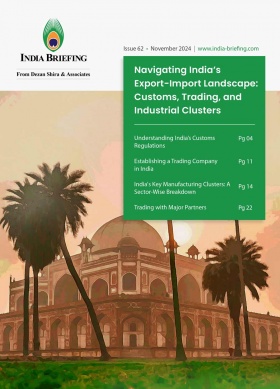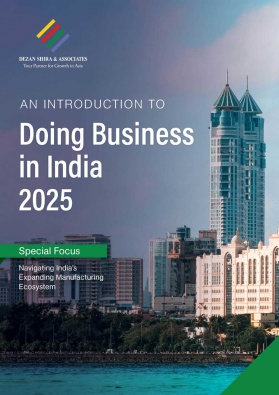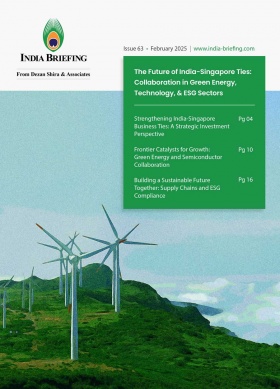Profiling India-Singapore Bilateral Trade and Investment Relations
India and Singapore maintain a robust relationship under the India-Singapore Strategic Partnership. As a key trading partner in Southeast Asia, Singapore’s prominence is a testament to the success of the Comprehensive Economic Cooperation Agreement (CECA) between the two nations. Furthermore, Singapore remains India’s leading source of foreign direct investment, with its firms playing an active role in urban planning and infrastructure development. This article examines the prevailing trade and investment dynamics between India and Singapore.
India and Singapore continue to enhance their bilateral trade and economic cooperation, with a growing focus on maritime collaboration. On March 25, 2025, the two countries signed a letter of intent (LoI) on Green Digital Shipping Corridor (GDSC) to strengthen trade efficiency, promote sustainability, and advance technological integration in the shipping sector. This latest collaboration aligns with India’s push for green fuel exports and digital port modernisation, while leveraging Singapore’s strategic position as a global maritime hub.
Singapore is a key economic partner for India, with bilateral relations strengthened by the India-Singapore Strategic Partnership. It is India’s largest trade partner in the ASEAN region and the eighth-largest globally. It has consistently been the leading source of foreign direct investment (FDI) into India and is a major contributor to external commercial borrowings and foreign portfolio investment (FPI). In the July-September quarter of FY 2024-25, Singapore accounted for 50 percent of India’s total FDI inflows, with a 43 percent increase in FDI to US$13.6 billion. From April 2000 to March 2024, Singapore’s cumulative FDI contribution to India amounted to approximately US$159.94 billion.
Earlier in January 2025, Singaporean President Tharman Shanmugaratnam visited to India, from January 14-18, 2025, including a two-day visit to Odisha state from January 17-18. This was the first official visit by a Singapore president to India in a decade.
During Prime Minister Narendra Modi’s official visit to Singapore on September 4-5, 2024, both countries signed four key agreements, particularly focusing on the semiconductor sector.
India-Singapore strengthen maritime ties with GDSC
On March 25, 2025, India and Singapore formalized an agreement by signing an LOI focused on maritime digitalization and decarbonization. The agreement, signed by the Chief Executive of the Maritime and Port Authority of Singapore and India’s Joint Secretary of the Ministry of Ports, Shipping, and Waterways (MoPSW), aims to establish a GDSC that will enhance cooperation in reducing greenhouse gas (GHG) emissions and integrating advanced digital solutions in the maritime industry.
Under the LOI, both countries will collaborate on projects aimed at maritime digitalization and decarbonization. This includes identifying key stakeholders who can contribute to the initiative and working toward formalizing a comprehensive memorandum of understanding on the Singapore-India GDSC.
For India, the GDSC will serve as a catalyst in positioning the country as a global leader in green fuel exports while modernizing port infrastructure through digital advancements. Singapore, on the other hand, will further solidify its status as a premier maritime hub by adopting sustainable shipping practices and leveraging India’s technological expertise. On a broader scale, the initiative sets a precedent for environmentally friendly shipping corridors worldwide, creating a replicable model for reducing carbon footprints in maritime trade.
India-Singapore bilateral relationship framework
India-Singapore relations were elevated to a Comprehensive Strategic Partnership in September 2024.
India and Singapore have enjoyed a multifaceted bilateral relationship over the past six decades, underpinned by shared values and economic opportunities. The two countries have extensive political and defense ties, growing economic and technological cooperation, and vibrant cultural and human links. Both countries are members of several forums, including the East Asia Summit, G20, Commonwealth, IORA (Indian Ocean Rim Association), and IONS (Indian Ocean Naval Symposium), reflecting their convergence on international issues.
To provide a larger framework for activities, the two countries have concluded several agreements, including the CECA, the Double Taxation Avoidance Agreement, the Bilateral Air Services Agreement, the Defense Cooperation Agreement, the Mutual Legal Assistance Treaty, and the Mutual Recognition Agreement on Nursing. The Joint Ministerial Committee and India-Singapore Ministerial Roundtable are among the more than 20 regular bilateral mechanisms, dialogues, and exercises.
The inaugural meeting of the India-Singapore Ministerial Roundtable (ISMR) took place in September 2022 in New Delhi, aimed at taking bilateral relations to new heights. The discussion focused on existing and emerging areas of cooperation such as digital connectivity, fintech, the green economy, green hydrogen, skill development, and food security. The meeting paved the way for further enhancing the strategic partnership between India and Singapore. During the visit, a Fintech Cooperation Agreement was signed between the Monetary Authority of Singapore (MAS) and the International Financial Services Centers Authority (IFSCA) in Gujarat.
The second round of the ISMR was held in Singapore on August 26, 2024. The meeting reviewed the progress of the India-Singapore Strategic Partnership, focusing on key pillars identified during the first ISMR: digitalization, skills development, sustainability, and healthcare and medicine. Two additional pillars, advanced manufacturing and connectivity, were introduced to further strengthen bilateral cooperation.
Trends in India-Singapore trade relations
The India-Singapore CECA has played a significant role in boosting bilateral trade, which expanded from US$6.7 billion in FY 2005 to US$35.61 billion in FY 2024. India and Singapore’s bilateral trade in FY 2023-24 recorded a rise in exports at US$14.41 million, growing 20.19 percent year-on-year. In FY 2022-23, bilateral trade was worth US$35.58 million and recorded a 7.55 percent year-on-year growth in exports – at US$11.99 million.
Singapore is India’s sixth largest trade partner (FY24), accounting for 3.2 percent of India’s overall trade. India is Singapore’s 12th largest trade partner with a 2.3 percent share in Singapore’s overall trade. Singapore is India’s largest trade partner in the ASEAN region.
|
India-Singapore Trade Trends (Value in US$ Million) |
||
|
Year |
Exports to Singapore |
Imports from Singapore |
|
FY 2005 |
4000.6 |
2651.4 |
|
FY 2006 |
5425.3 |
3353.8 |
|
FY 2007 |
6053.8 |
5484.3 |
|
FY 2008 |
7379.2 |
8122.6 |
|
FY 2009 |
8444.9 |
7654.9 |
|
FY 2010 |
7592.2 |
6454.6 |
|
FY 2011 |
9825.4 |
7139.3 |
|
FY 2012 |
16857.7 |
8600.3 |
|
FY 2013 |
13,619.3 |
7,486.4 |
|
FY 2014 |
12,510.5 |
6,762.5 |
|
FY 2015 |
9,809.4 |
7,124.5 |
|
FY 2016 |
7,719.81 |
7,308.38 |
|
FY 2017 |
9,564.58 |
7,086.57 |
|
FY 2018 |
10,202.82 |
7,466.99 |
|
FY 2019 |
11,572.27 |
16,281.64 |
|
FY 2020 |
8,922.66 |
14,746.78 |
|
FY 2021 |
8,675.50 |
13,304.92 |
|
FY 2022 |
11,150.61 |
18,962.19 |
|
FY 2023 |
11,993 |
23,595 |
| FY 2024 | 14,414 |
21,199 |
Major exports from India to Singapore
In FY 2024, India exported a total of 4,657 commodities to Singapore, generating export revenue of US$14,414 million. Petroleum products, residual chemicals and allied products, and ship, boat, and floating structures were among the major items exported from India to Singapore, accounting for US$9,407 million of total export revenue, followed by electrical machinery and equipment, gold and other precious metals, organic chemicals, lead and products made of lead, electronics instruments, accounting for US$2,471 million.
During the first eight months of FY 2025 (April to November 2024), India’s exports to Singapore amounted to US$9,404 million. Petroleum products (US$3,318 million), ships, boats, and floating structures (US$1,651 million), and electrical machinery and equipment (US$1,111 million) were among the top commodities exported during this period.
Major imports by India from Singapore
In FY 2024, India imported 3,760 commodities from Singapore, totaling US$21.20 billion. Electronic components, coal, coke, and briquettes, and computer hardware and peripherals dominated India’s import basket from Singapore in terms of value, amounting to US$6,801 million, followed by ship, boat, and floating structures, plastic raw materials, organic chemicals, and petroleum products valued at US$4,734 million.
Between April and November 2024, India’s imports from Singapore totaled US$13.91 billion. Top imported commodities were electronics components worth US$1,999 million, followed by coal, coke, and briquettes worth US$1,398 million, and computer hardware and peripherals worth US$1,328 million.
Economic ties and investment opportunities between India and Singapore
In FY 2023-24, Singapore was India’s largest source of FDI, with equity inflows amounting to US$11.774 billion. Cumulative FDI inflows from Singapore to India totaled US$167.47 billion (April 2000–September 2024), accounting for 24 percent of India’s total FDI inflows.
Key sectors in India attracting FDI equity from Singapore include the services sector, computer software and hardware, trading, telecommunications, and pharmaceuticals.
India’s cumulative outward FDI to Singapore reached US$90.578 billion between January 2008 and June 2024. Annual outward FDI to Singapore stood at US$4.872 billion in FY 2023-24, US$4.81 billion in FY 2022-23, and US$7.18 billion in FY 2020-21.
About 9000 Indian companies are registered in Singapore, with notable public sector units, banks, and trade organizations like India Tourism, CII, FICCI, etc. having their offices there.
Over 440 companies from Singapore are registered in India, with two banks (Development Bank of Singapore and United Overseas Bank), as well as trade and business facilitation agencies like Enterprise Singapore, the Economic Development Board, and the Singapore Tourism Board having offices here.
India-Singapore tourism and connectivity
India is among Singapore’s top tourist markets, and in October 2024, Indian visitors surpassed one million, 2 months earlier than recorded in 2023. The Singapore Tourism Board (STB) notes that with over a 12 percent increase, India is Singapore’s third-largest source market for tourism.
Singapore is well-connected to India with 17 direct air routes from major metros like Mumbai, Delhi, Chennai, and Bengaluru, as well as Tier 2 cities such as Kolkata, Bhubaneswar, and Trivandrum. Most Indian cities enjoy proximity with Singapore as flight durations are 3.5-5 hours. Around 280 weekly flights ensure convenient and accessible travel between the two countries.
Singapore provides a streamlined visa process for Indian travelers, with visas typically issued within 3 to 5 business days through over 100 authorized agents. Multi-entry visas are available, valid for 30 days to up to a year.
Fintech and cross-border trade and finance
Cooperation in the areas of technology, innovation, fintech, and startups has also grown between India and Singapore.
Key commercial and technical arrangements have been established to enable the acceptance of RuPay cards in Singapore. The UPI-PayNow linkage marks a significant milestone in cross-border fintech, making Singapore the first country to launch a cross-border person-to-person (P2P) payment system with India. PayNow is the fast payment system of Singapore, which enables peer-to-peer funds transfer services available to retail customers through participating banks and Non-Bank Financial Institutions (NFIs) in the country. It enables users to send and receive instant funds from one bank or e-wallet account to another in Singapore by using just their mobile number, Singapore NRIC/FIN, or VPA.
Other notable initiatives include ONDC-Proxtera connectivity, which positions Proxtera as the first international buyer app linked to ONDC; GIFT Connect, a collaboration between the National Stock Exchange of India (NSE) and the Singapore Exchange (SGX) to create a unified liquidity pool for NIFTY products in GIFT City; and TradeTrust, which facilitates interoperable electronic Bills of Lading (eBLs) for seamless cross-border trade finance transactions.
Skill development
India and Singapore are collaborating on establishing skill development centers across various sectors. Skill centers, supported by public and private initiatives, have been completed in six locations in India: Himachal Pradesh, Delhi, Rajasthan (Udaipur), Assam (Guwahati), Odisha (Bhubaneswar), and Telangana (Hyderabad).
Two additional centers in Madhya Pradesh (Bhopal) and Gujarat (Gandhinagar) are currently underway. During the Prime Minister Modi’s visit to Singapore in September 2024, both nations exchanged an MoU on cooperation in education and skill development.
[The article was originally published on January 15, 2025. It has since been updated March 26, 2025.]
About Us
India Briefing is one of five regional publications under the Asia Briefing brand. It is supported by Dezan Shira & Associates, a pan-Asia, multi-disciplinary professional services firm that assists foreign investors throughout Asia, including through offices in Delhi, Mumbai, and Bengaluru in India. Readers may write to india@dezshira.com for support on doing business in India. For a complimentary subscription to India Briefing’s content products, please click here.
Dezan Shira & Associates also maintains offices or has alliance partners assisting foreign investors in China, Hong Kong SAR, Dubai (UAE), Indonesia, Singapore, Vietnam, Philippines, Malaysia, Thailand, Bangladesh, Italy, Germany, the United States, and Australia.
- Previous Article Indian Steel and Aluminum Exports Face Uncertainty as US Tariffs Loom
- Next Article India to End Equalisation Levy on Digital Ads by April 1, 2025









